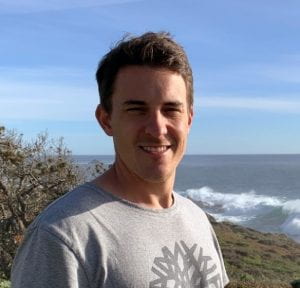
Post-doctoral Fellow
Department of Earth and Planetary Sciences
michael.tatzel[at]uni-goettingen[dot]de
Research interests: Mg, Sr, and Ca isotopes in Microbial Dolomites
Biography
I grew up in the Central German Uplands, in a rural landscape rich in forests and meadows growing on folded, Paleozoic deep-sea sediments and unconformably overlain, river-lain, red sandstones of Lower Mesozoic age. Loving the outdoors and practical sciences, I decided to study Earth Sciences in the small university city Göttingen. Soon I became fascinated with geochemistry, especially of rare earth elements. Following a year abroad as exchange student at Scripps Institution of Oceanography in San Diego I returned to complete my master’s degree. Intrigued by low-temperature thermochronology, I studied sediment provenance and the fluvial history of the River Rhine using detrital zircon (U-Th)/He dating. For my PhD I turned to novel metal isotopes at the German Research Centre for Geosciences in Potsdam. I studied early silica diagenesis in siliceous sediment from the Southern Ocean to understand Si isotope fractionation during the diagenetic process of chert formation. Using silicon stable isotopes and redox-sensitive elements I studied the expansion of siliceous sponges and the oxygenation of seawater during the Precambrian-Cambrian transition.
During my early career I diversified my scope in a range of projects including Si isotopes and element ratios in enstatite chondrites and their role as building blocks for silicate Earth, sources of magnesium in pore waters of deep-sea sediments, magnesium isotopes in the mammalian food chain and the development of a method that allows obtaining more precise triple isotope fractionation exponents of metal(oid) elements. Focusing my early career on Earth surface processes, I came as DFG fellow to UC Santa Cruz to study microbial dolomite formation.
Research
The dolomite problem, the vast presence of dolomite in the geological record and its scarcity in modern environments is a long-standing enigma in the Earth Sciences. The amount of dolomite formed by microbial mediation has potentially changed throughout Earth history, but their identification in the geological archive is currently not possible with available mineralogical or geochemical tools. I hypothesize that the involvement of microorganisms in the formation of these dolomites induces unique isotopic signatures that could be used as “bio-signatures” and thus contribute to solving the dolomite problem. In this project I determine Mg, Sr and Ca isotope fractionation during microbial dolomite formation. I investigate biogenic dolomites that form in microbial mats in extreme, hypersaline environments in Qatar and Brazil as well as dolomites formed under laboratory conditions.